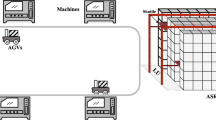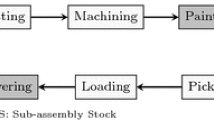Abstract
This paper investigates an integrated scheduling of production and distribution activities in the supply chain where both machine deterioration and learning effects have been consequently addressed. Manufacturer aims to minimize the total weighted completion time, while a distributor focuses on reducing shipping times with batch delivery by using capacitated vehicles. The aim of this problem is to minimize the sum of weighted completion times plus total delivery times. First, a mixed integer linear programming model is proposed. Then for a special case, a branch and bound algorithm is developed with utilizing the structural features of the problem. In order to solve large-scale instances of the general problem in a short/reasonable time, a simulated annealing algorithm is provided. Computational results show that the proposed heuristic techniques have high efficiency to achieve the optimal solution, and that they are useful to solve large sizes of the problems at a short time. Finally, by providing a real-life case of wax manufacturing and its distribution system, it is shown that the application of integrated decisions can significantly reduce costs imposed on the firms.






Similar content being viewed by others
References
Graham RL et al (1979) Optimization and approximation in deterministic sequencing and scheduling: a survey. Ann Discret Math 5:287–326
Haddad H, Ghanbari P, Moghaddam A (2012) A new mathematical model for single machine batch scheduling problem for minimizing maximum lateness with deteriorating jobs. Int J Ind Eng Comput 3(2):253–264
Huang X, Wang M-Z, Wang J-B (2011) Single-machine group scheduling with both learning effects and deteriorating jobs. Comput Ind Eng 60(4):750–754
Ji M, He Y, Cheng TCE (2007) Batch delivery scheduling with batch delivery cost on a single machine. Eur J Oper Res 176(2):745–755
Karimi-Nasab M, Sabri-Laghaie K (2014) Developing approximate algorithms for EPQ problem with process compressibility and random error in production/inspection. Int J Prod Res 52(8):2388–2421
Karimi-Nasab M, Seyedhoseini SM (2013) Multi-level lot sizing and job shop scheduling with compressible process times: a cutting plane approach. Eur J Oper Res 231(3):598–616
Kirkpatrick S, Gelatt CD, Vecchi MP (1983) Optimization by simmulated annealing. Science 220(4598):671–680
Mazdeh M, Rostami M (2014) A branch-and-bound algorithm for two-machine flow-shop scheduling problems with batch delivery costs. Int J Syst Sci Oper Logist 1(2):94–104
Mazdeh MM, Sarhadi M, Hindi KS (2007) A branch-and-bound algorithm for single-machine scheduling with batch delivery minimizing flow times and delivery costs. Eur J Oper Res 183(1):74–86
Mazdeh MM et al (2011) Single-machine batch scheduling minimizing weighted flow times and delivery costs. Appl Math Model 35(1):563–570
Mazdeh MM, Rostami M, Namaki MH (2013) Minimizing maximum tardiness and delivery costs in a batched delivery system. Comput Ind Eng 66(4):675–682
Pundoor G, Chen Z-L (2005) Scheduling a production-distribution system to optimize the tradeoff between delivery tardiness and distribution cost. Wiley, Hoboken
Rostami M, Kheirandish O, Ansari N (2015a) Minimizing maximum tardiness and delivery costs with batch delivery and job release times. Appl Math Model 39(16):4909–4927
Rostami M, Pilerood A, Mazdeh M (2015b) Multi-objective parallel machine scheduling problem with job deterioration and learning effect under fuzzy environment. Comput Ind Eng 85:206–215
Selvarajah E, Steiner G, Zhang R (2013) Single machine batch scheduling with release times and delivery costs. J Sched 16(1):69–79
Wang J-B (2007) Single-machine scheduling problems with the effects of learning and deterioration. Omega 35(4):397–402
Wang X, Edwin Cheng TC (2007) Single-machine scheduling with deteriorating jobs and learning effects to minimize the makespan. Eur J Oper Res 178(1):57–70
Wang J-B, Wang C (2011) Single-machine due-window assignment problem with learning effect and deteriorating jobs. Appl Math Model 35(8):4017–4022
Wang J-B et al (2009) Learning effect and deteriorating jobs in the single machine scheduling problems. Appl Math Model 33(10):3848–3853
Wang J-B, Wang M-Z, Ji P (2011) Single machine total completion time minimization scheduling with a time-dependent learning effect and deteriorating jobs. Int J Syst Sci 43(5):861–868
Yin Y et al (2013) Single-machine batch delivery scheduling with an assignable common due window. Omega 41(2):216–225
Yin Y et al (2014) A branch-and-bound algorithm for a single machine sequencing to minimize the total tardiness with arbitrary release dates and position-dependent learning effects. Inf Sci 256:91–108
Yunqiang Y et al (2012) Single-machine scheduling with job-position-dependent learning and time-dependent deterioration. IEEE Trans Syst Man Cybern Part A Syst Hum 42(1):192–200
Acknowledgements
We should hereby thank a number of people for their sincere helps and supports provided at different stages of this research: the anonymous reviewers for their valuable comments, the staff at the Arya Solar Company and SOC for supporting us with their data, and finally Dr. Morteza Bagherpour for his guidance through this research.
Author information
Authors and Affiliations
Corresponding author
Appendices
Appendix 1
This Proposition can be proved through exchanging the processing positions of two jobs i and j. Consider the sequence s where job j immediate precedes job i for processing at position r and \(\frac{{\hat{p}_{i} }}{{w_{i} }} \le \frac{{\hat{p}_{j} }}{{w_{j} }}\). Under the agreeable ratio assumption, it is clear that \(p_{i} \le p_{j}\) and \(w_{i} \ge w_{j}\), Two states occur for jobs i and j:
State I Both jobs belong to a batch. We know that completion times for all jobs placed in a single batch are the same and equal to the completion time of latest job processed for that batch. In this case, the value of completion time for job i is given as below:
where t is the completion time of a job scheduled before these two jobs. Like the sequence s, now, consider the sequence \(s^{\prime}\) for the same batch where i is exchanged by j. So, the completion time for j which follows i for processing is given as below:
Now, we can calculate the value of \(C_{i}^{s} - C_{j}^{{s^{\prime}}}\), since \(r^{\beta } - \left( {r + 1} \right)^{\beta } > 0\):
It can be concluded that the sequence \(s^{\prime}\) have priority over the sequence s. It should be noted that without considering learning effect and deterioration, the different sequences in each batch have no effect on completion time of the batch.
State II The jobs belong to different batches, i.e. the border of two consecutive batches. Suppose that in sequence s, jobs j and i belong to batch A and B, respectively. Also, it is assumed that by exchanging position of two jobs, the vehicle capacity constraint is not violated. In this case, the value of completion times for batch A and B are given as below:
where t is the completion time of a job scheduled before job j and \(t^{\prime}\) is the sum of processing times of jobs belong to batch B and scheduled after job i. Therefore, the total weighted completion times (TWCT) of two batches A and B in sequence s is given as below:
where \(W_{t}\) is the sum of weights of jobs belonging to batch A scheduled before job j and \(W_{{t^{\prime}}}\) is the sum of weights of jobs belonging to batch B scheduled after job i. Like the sequence s, now, consider the sequence \(s^{\prime}\) where i is exchanged by j. Therefore, the total weighted completion times (TWCT) of two batches A and B in sequence \(s^{\prime}\) is given as below:
Then we have:
First, we show that \(C_{A}^{s} - C_{A}^{{s^{\prime}}} > 0\) and \(C_{B}^{s} - C_{B}^{{s^{\prime}}} > 0\):
So we have
Since \(w_{i} \ge w_{j}\), \(p_{j} \ge p_{i}\) and \(r^{\beta } > \left( {r + 1} \right)^{\beta }\):
It means that the value of total weighted completion times of Sequence \(s^{\prime}\) is less than of Sequence s. Therefore, the sequence \(s^{\prime}\) where jobs are sorted by WSBPT rule has priority over the latter.□
Appendix 2
As stated, 12 different settings are determined based on the initial freezing, final freezing and amount of epoch. Table 12 shows these different settings.
For each setting, the results of solving 45 random instances have been presented in Table 13.
Table 14 shows the result of Friedman tests for each category. As is clear, the null hypothesis is rejected for all categories. In summary, for the small-size, medium-size, and large-sizes instances, the best settings are 3, 5, and 10, respectively.
Rights and permissions
About this article
Cite this article
Rostami, M., Nikravesh, S. & Shahin, M. Minimizing total weighted completion and batch delivery times with machine deterioration and learning effect: a case study from wax production. Oper Res Int J 20, 1255–1287 (2020). https://doi.org/10.1007/s12351-018-0373-6
Received:
Revised:
Accepted:
Published:
Issue Date:
DOI: https://doi.org/10.1007/s12351-018-0373-6




